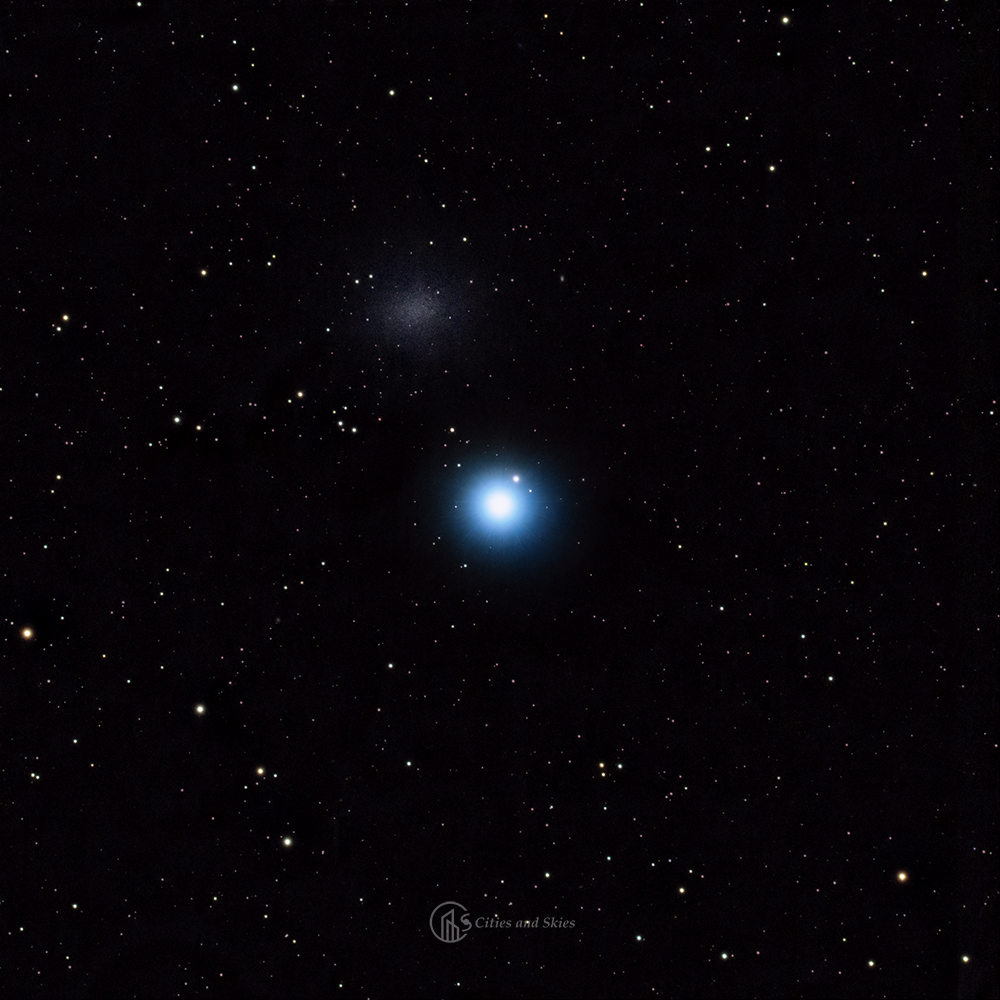The brightest star of the Leo constellation is alpha Leonis. Today it is known as Regulus, but it had a variety of names in different cultures. And most astrophysicists do not know that it is a star system known by amateurs astronomers as ‘Regulus, the pendulum’. Why? Let’s find out!
This star and its location are special for various reasons. For one thing, Regulus is right on the ecliptic (the plane of the Solar system). Therefore, all the major and minor planets are passing by this star as they orbit the Sun. It is also quite close to the celestial equator (the projection of Earth’s equator on the sky). The point where these two celestial planes meet is where the Sun resides during the fall equinox when the night and the day are the same lengths everywhere on Earth. And as a bonus, as we will see below, it appears close to a galaxy that is very special on its own.
Regulus is hot!
We learned earlier that O spectral type stars are the hottest and most luminous among normal stars. Somewhat cooler, but still very hot stars are the B spectral type, of which Regulus is a good example. In comparison to our Sun, it is about four times as massive, four times as large, twice as hot, and 300 times as bright! Remember, stars “burn” their hydrogen. The more massive, the more rapidly. Regulus was therefore thought to be a relatively young star for a long time. It appears this is not the case! It has a company in a very tight orbit: a very old star that used most of its hydrogen in its core. Once upon a time, this was a well-known paradox in astronomy, and we will talk about it later. But for now, let’s just say: relationships can get things complicated even in a star’s life.
A system of stars – the pendulum
Well, a good fraction of stars do not get along well alone, they prefer to form pairs or even multiple stellar systems. Regulus is no different. Its closest companion is not visible through telescopes. But it has a pair of companions (another tight binary) that is seen as a single faint star next to alpha Leonis in small telescopes. In the picture, it is a bit up and to the right from Regulus. But why are they referred to as the pendulum? This is because there is a fun optical illusion when you slightly move the telescope back and forth in one direction. Faint objects are not easily seen when they move, but the light-collecting cells in our eyes do remember these objects for some time. For this reason, while Regulus keeps moving, its companion keeps lagging behind, mimicking a pendulum or swing effect. You should definitely try this one!
Leo I, the dwarf galaxy
Above Regulus, the pendulum, there is a faint smudge in the image (a bit to the left; you may have to adjust the brightness of your screen!). This is actually a dwarf galaxy. Our Milky Way is part of the Local Group. Other members are the Andromeda Galaxy, the Triangulum Galaxy, the Magellanic Clouds, and a number of other small (spheroidal or irregular) dwarf galaxies. The Leo I spheroidal dwarf galaxy is the most faraway satellite galaxy of the Milky Way. Capturing it with a small telescope, from the town, right next to a bright star was a great success for us! Here is another great shot of these fascinating targets.
Together with the Local Group and the Virgo Cluster (of which the Markarian Chain is part) form the Virgo Supercluster. And that may be a part of an even bigger supercluster. Well, as Douglas Adams wrote: “Space is big. You just won’t believe how vastly, hugely, mind-bogglingly big it is. I mean, you may think it’s a long way down to the chemist’s, but that’s just peanuts to space”.
Observing Log
And just like that, spring! The Sun was shining all day, it got suddenly warm. Crystal clear nights are predicted, two in a row. Moon is almost full but found an interesting target that may still be ok. The temperature is about 10 deg., the camera can still cool down to -20 C but close to full power (~80%). Started shooting at around 21:45 CET, before moonrise. Some high-altitude clouds appeared at the end. Skye noise is an issue, we are having trouble correcting for the background even when using flats.
There is a ghost image as well that appears next to Regulus, in slightly different positions as we track the target. After the meridian flip, there was a big jump in its position. We have seen this earlier near very bright stars. It is a “fun” challenge to bring out the exciting object in the field: the Leo I dwarf galaxy. Bea is doing some tricks and eventually removes the “bubbles” caused by the dust on the filter, the disturbing ghost, and still manages to stretch the picture enough to be able to see Leo I. This is a very low surface brightness object.
Regulus, the pendulum, and Leo I, 3 h
Hoogeveen, Netherlands
29 March 2021 (Monday), ~full Moon
60x180s shots
William Optics GT81, f/5.9
Flattener 6AIII 0.8x
ZWO ASI533MC-P, gain 101, -20 deg.
WO Uniguide 50/200 with ASI120MMmini
iOptron CEM40
Optolong L-Pro
ASIair
Bortle~5 (our region; in the town, it should be worse)
Astro Pixel Processor, Photoshop
